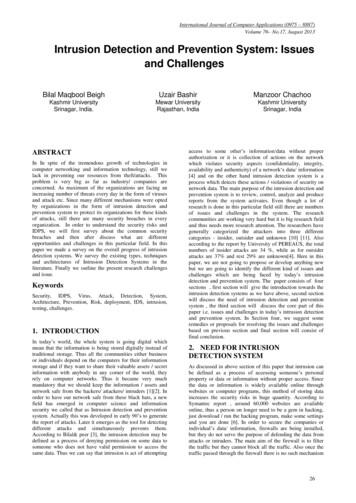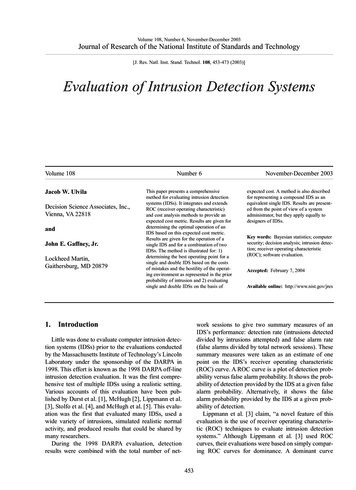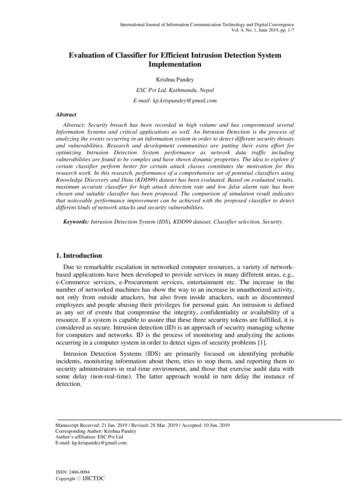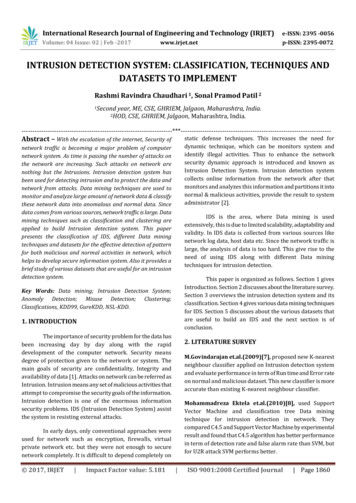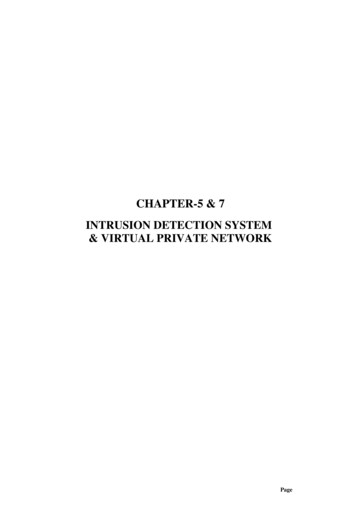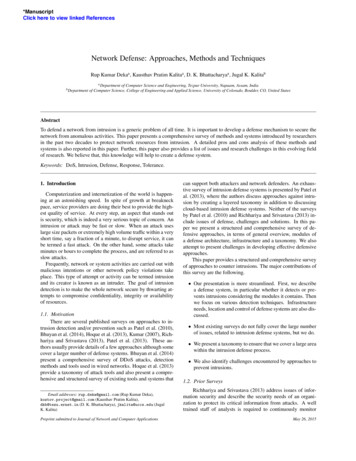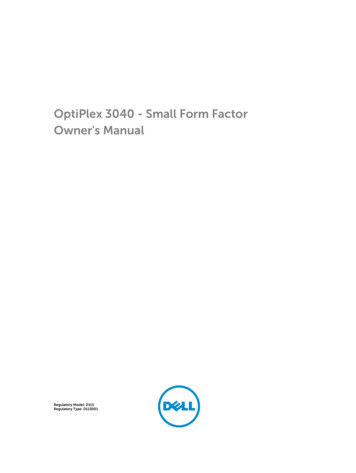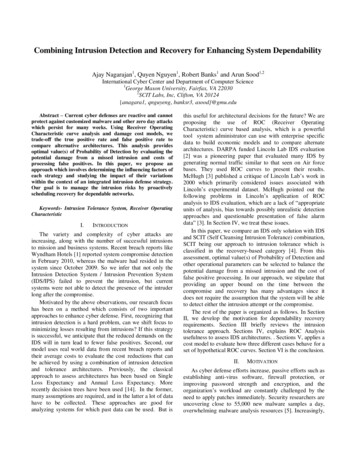
Transcription
Combining Intrusion Detection and Recovery for Enhancing System DependabilityAjay Nagarajan1, Quyen Nguyen1, Robert Banks1 and Arun Sood1,2International Cyber Center and Department of Computer Science1George Mason University, Fairfax, VA 220302SCIT Labs, Inc, Clifton, VA 20124{anagara1, qnguyeng, banksr3, asood}@gmu.eduAbstract – Current cyber defenses are reactive and cannotprotect against customized malware and other zero day attackswhich persist for many weeks. Using Receiver OperatingCharacteristic curve analysis and damage cost models, wetrade-off the true positive rate and false positive rate tocompare alternative architectures. This analysis providesoptimal value(s) of Probability of Detection by evaluating thepotential damage from a missed intrusion and costs ofprocessing false positives. In this paper, we propose anapproach which involves determining the influencing factors ofeach strategy and studying the impact of their variationswithin the context of an integrated intrusion defense strategy.Our goal is to manage the intrusion risks by proactivelyscheduling recovery for dependable networks.Keywords- Intrusion Tolerance System, Receiver OperatingCharacteristicI.INTRODUCTIONThe variety and complexity of cyber attacks areincreasing, along with the number of successful intrusionsto mission and business systems. Recent breach reports likeWyndham Hotels [1] reported system compromise detectionin February 2010, whereas the malware had resided in thesystem since October 2009. So we infer that not only theIntrusion Detection System / Intrusion Prevention System(IDS/IPS) failed to prevent the intrusion, but currentsystems were not able to detect the presence of the intruderlong after the compromise.Motivated by the above observations, our research focushas been on a method which consists of two importantapproaches to enhance cyber defense. First, recognizing thatintrusion detection is a hard problem, can we shift focus tominimizing losses resulting from intrusions? If this strategyis successful, we anticipate that the reduced demands on theIDS will in turn lead to fewer false positives. Second, ourmodel uses real world data from recent breach reports andtheir average costs to evaluate the cost reductions that canbe achieved by using a combination of intrusion detectionand tolerance architectures. Previously, the classicalapproach to assess architectures has been based on SingleLoss Expectancy and Annual Loss Expectancy. Morerecently decision trees have been used [14]. In the former,many assumptions are required, and in the latter a lot of datahave to be collected. These approaches are good foranalyzing systems for which past data can be used. But isthis useful for architectural decisions for the future? We areproposing the use of ROC (Receiver OperatingCharacteristic) curve based analysis, which is a powerfultool system administrator can use with enterprise specificdata to build economic models and to compare alternatearchitectures. DARPA funded Lincoln Lab IDS evaluation[2] was a pioneering paper that evaluated many IDS bygenerating normal traffic similar to that seen on Air forcebases. They used ROC curves to present their results.McHugh [3] published a critique of Lincoln Lab‟s work in2000 which primarily considered issues associated withLincoln‟s experimental dataset. McHugh pointed out thefollowing problems in Lincoln‟s application of ROCanalysis to IDS evaluation, which are a lack of “appropriateunits of analysis, bias towards possibly unrealistic detectionapproaches and questionable presentation of false alarmdata” [3]. In Section IV, we treat these issues.In this paper, we compare an IDS only solution with IDSand SCIT (Self Cleansing Intrusion Tolerance) combination,SCIT being our approach to intrusion tolerance which isclassified in the recovery-based category [4]. From thisassessment, optimal value(s) of Probability of Detection andother operational parameters can be selected to balance thepotential damage from a missed intrusion and the cost offalse positive processing. In our approach, we stipulate thatproviding an upper bound on the time between thecompromise and recovery has many advantages since itdoes not require the assumption that the system will be ableto detect either the intrusion attempt or the compromise.The rest of the paper is organized as follows. In SectionII, we develop the motivation for dependability recoveryrequirements. Section III briefly reviews the intrusiontolerance approach. Sections IV, explains ROC Analysisusefulness to assess IDS architectures. . Sections V, applies acost model to evaluate how three different cases behave for aset of hypothetical ROC curves. Section VI is the conclusion.II.MOTIVATIONAs cyber defense efforts increase, passive efforts such asestablishing anti-virus software, firewall protection, orimproving password strength and encryption, and theorganization‟s workload are constantly challenged by theneed to apply patches immediately. Security researchers areuncovering close to 55,000 new malware samples a day,overwhelming malware analysis resources [5]. Increasingly,
automated analysis technologies are used to keep up withthe volume, but they still lack the precision to deciphercompressed, encrypted, and obfuscated malware [6].McAfee recent crash of tens of thousands of PCs globallyillustrates the unpredictable system effects after compromiseand their collateral damage, which creates even moreuncertainty and less dependability for Enterprise Security[7].The current reactive cyber defense approaches areexpensive and inadequate. We expect that, automatedrecovery and Intrusion Tolerance System (ITS) will beuseful in addressing the increasing malware and patchworkload, but what are the cost impacts of malicious threatsand false positives on dependability and security attributes?III.INTRUSION TOLERANCE APPROACHITS architecture objective is to tolerate unwantedintrusions and restore the system to its normal state. VariousITS approaches are reviewed by Nguyen and Sood [4]. Inour paper, we use the recovery-based SCIT (Self-CleansingIntrusion Tolerance) model [4], which is applicable toservers that are open to the Internet, such as Web, and DNSservers [8]. Using round-robin cleansing, at any point intime, a server in a SCIT cluster can have one of the threestates: offline cleansing, offline spare and online transactionprocessing. The duration that a SCIT server is exposed tothe Internet is called its Exposure Time. The architecture issimple, and does not rely on intrusion detection.Implementation of SCIT scheme can be based onvirtualization. The interfaces between controller and thegroup of servers to be protected are trusted.Another benefit of a recovery-based ITS is to shrinkdown breach duration, which has the effect of reducinglosses and their costs. Indeed, this intrusion tolerancestrategy would mitigate the effects of malicious attacks.Intrusion detection is known to be a hard problem, andcurrent cyber defense systems reportedly detect less thanhalf the malware. Still servers and apps account for 98% ofthe total record compromised. Verizon DBIR 2010 [9]underscores this problem by noting that only 11% of thecompromises were detected within minutes or hours. Thus,current cyber defenses cannot protect systems againstcustomized malware and other zero day attacks; once anattack is successful, it can persist for many weeks. Thisemphasizes the need for a recovery-based IntrusionTolerance approach since detection triggered ITS mightagain fall short of the needs.IV.RECEIVER OPERATING CHARACTERISTIC (ROC)ROC analysis has been long used in signal detectiontheory to present the tradeoff between hit-rates and falsepositive rates of classifiers. ROC analysis was initially usedduring World War II in the analysis of radar signals todifferentiate signal from noise. It was soon introduced inPsychology to map the perceptual detection of signals [10].ROC curves are useful for assessing the accuracy ofpredictions. A ROC curve plots the fraction of true positives(hits) versus the fraction of false positives, and hence has adirect relationship with diagnostic decision making. Theideal prediction method would yield a co-ordinate (0, 1) onthe ROC curve. This represents 100 % true positives andzero percent false-positives, and is referred to as the perfectclassification.A. Using ROC to assess IDS quality.The most attractive feature of ROC analysis is the factthat the tradeoff between probability of detection andprobability of false positive can be derived directly. Thisallows a system administrator to instantly determine howwell a classifier performs and also to compare twoclassifiers. We care about false positives in addition to theprobability of detection since there is a need to characterizehuman workload involved in analyzing false positivesgenerated by traffic. According to [2], false positive ratesabove 100‟s per day could make IDS almost useless evenwith high probability of detection since security analystsmust spend hours each day investigating false positives.DARPA funded Lincoln Lab IDS evaluation [2] appearsto be the first to perform tests to evaluate many IDS bygenerating normal traffic similar to that on a governmentsite. McHugh [3] reviews and analyzes the validity andadequacy of artificial data used to estimate real worldsystem performance. In this paper, we present amethodology to compare various IDS‟s, each of which isrepresented by a ROC curve. We utilize Verizon‟s 2010results representing a cross section of multiple industries.Furthermore, these data validate firsthand real worldevidence over a broad five year range from 2004-2009 withthe addition of US Secret Service confirmed cases.The Lincoln Lab experiment used ROC for presentingthe results of the evaluation. McHugh [3] criticized LincolnLab‟s use of ROC curves primarily on the followinggrounds. We have attempted to address each of theseconcerns in our work: Determining appropriate units of analysis. Unit ofanalysis is the quantity of input on which a decision ismade. Lincoln lab used sessions as the unit of analysis,the problems of which were outlined in [3]. McHughalso emphasized the need for using similar units ofanalysis across all IDS‟s to be evaluated. In our case,we consider a simple system and consistently use query/ packet as our unit of analysis across all IDS‟s. Errors per unit time. In [2], a pseudo-ROC curve withx-axis as False Positives per day instead of PercentageFalse Positives was used. This led to two incomparableunits being used on two axes, and the results in turnbecame strongly influenced by factors like the data ratethat should typically be irrelevant. In this paper, weconsistently use probability of detection and that offalse positives for all ROC curves. In such a case, giventhat the distributions of signal and noise are realistic,
McHugh [3] recognizes that the ROC presentationshould give a good account of detector performance insimilar environments. Given enough characterizationsof the signal and noise distributions, McHugh furtheracknowledges that it is even possible to investigateoptimal detectors. McHugh [3] criticizes Lincoln Lab‟s methods ofscoring and constructing ROC curves which lead toproblems like bias towards unrealistic detectionapproaches, but not the use of ROC curves itself. In ourcase, the emphasis is not on constructing ROC curvesbut on comparing IDS‟s using our cost-model once wehave their respective ROC curves. While there is a needfor alternative taxonomies, the scoring method from theattacker‟s perspective is still utilized for real worldincidents.According to [2], there have been a number of similarefforts. In order to be able to compare multiple IDS systems,the ROC curves should be generated using similar orpreferably same test data. According to Orfila et al. [11], iftwo ROC curves intersect at some point, there is no way ofclaiming that one is better than the other since some systemadministrators might want high probability of detection (topright corner of ROC curve) and some might want lowprobability of false positive (bottom left corner of ROCcurve).Stolfo et al. [12] presents an alternative method toperform evaluation based on cost metrics. Authors helpformalize the costs involved in evaluating an IDS into threetypes: 1) Damage cost, 2) Challenge cost or Response costand 3) Operational cost.In [13], Drummond et al. propose the use of cost curvesfor evaluating classifiers. Cost curves plot expected cost vs.Probability Cost Function (PCF). Here PCF is a function ofprobability of detection, probability of false positive and itscorresponding costs. Although cost curves are good tocompare classifiers, the representation does not provide forthe system administrator to quickly see the cost trend ofoperating at different points (Pf, Pd) on the ROC curve. Also[13] does not suggest a way to determine the expected costof operating at a point on ROC curve.In [14], Gaffney et al. argued that both ROC analysisand cost analysis methods are incomplete. They useddecision analysis techniques and provide an expected costmetric that reflects IDS‟s ROC curve based on a decisiontree approach. This cost model requires a lot of data to becollected and does not reflect the magnitude of actual costsassociated with breach events. For this, we propose a costmodel for the calculation of expected cost of operating atany point on the ROC curve.V.COST MODELIn this section, we look to overcome each of theshortcomings of earlier approaches by proposing a costmodel that consists of two elements: A formula for the expected cost of operating at anypoint on the ROC curve Cost metrics derived from published breachinvestigation reportsA. Expected Cost calculation.The cost of operating IDS at any point on the ROCcurve (Pf, Pd) is a combination of the following: Operational Costs – Cost involved in operating the IDSand keeping it running. Damage Costs – the amount of damage caused by anintruder in case of a successful attack. Response Costs – the cost involved in responding to apotential intrusion on detection.Out of the three costs mentioned above, operationalcosts and response costs greatly vary from organization toorganization based on a number of factors like size of theorganization, type of organization etc. Since these two costsare not entirely quantifiable, for the purposes of this paper,we employ the objective function proposed in [15]:Expected Cost of operating at any point on the ROC curve Cost of Misses Cost of False Positives.Thus, for every point on the ROC curve (Pf, Pd), we have anexpected cost:Expected Cost (Cm*p*Pm) (Cf*(1-p)*Pf),whereCm – Cost of a missp – Prior probability of IntrusionCf – Cost of a false positivePd – Probability of detectionPm – Probability of a miss (1-Pd)Pf – Probability of a false positiveNote that this expected cost is for one incoming query. Ifthere are „n‟ incoming queries, the above expected cost mustbe multiplied by „n‟. The value of metrics used in the costmodel is summarized in Table 1.Table 1- Metrics values used in the Cost ModelMetricsValueExplanationMedian number of1,082Removes outliers. Betterrecords lost perestimate of the “typicalbreach (M)value”Average cost of 204Direct Cost: 60 compromisedIndirect Cost: 144record (D)M * D 1082 * 204Cost of a Miss (Cm) 220,000Cost of a FalsePositive (Cf)MedianCompromiseDuration per breach 40014 daysAssumption: Labor Cost Overhead Cost 400Compromise to Discoverytime Discovery toContainment timeRef[9][16][9],[16][9]In this paper, the probability of detection Pd and that of afalse positive Pf will constitute the operational parameters.We use the median number of records lost for assessingdamage. In many cases, the outliers in breach data can skewthe data, because most of the losses come from only a few
breaches. Therefore, the Mean becomes highly skewed andis not a good estimate of the typical number of records lostper breach. Median is a better estimate of the typical value[16].B. Evaluating classifiers using our Cost Model.For the purposes of this paper, we do not address howthe ROC curves are constructed. Proper construction anduse of ROC curves in Intrusion / Anomaly detection havebeen addressed in [17]. We just show how the cost modelcan be implemented once they are constructed. Figure 1gives a family of hypothetical ROC curves, eachrepresenting a classifier. We will implement our cost modelon these ROC curves in three different cases to evaluate theclassifiers‟ behaviors:CASE 1b. SCIT IDS: (Figure 3)Now we add SCIT to existing IDS and evaluate thesystem using our Cost Model. We assume that the exposuretime of SCIT is 4 hours 1 . This reduces the compromiseduration of the system from 14 days to 4 hours. We assumethat data is ex-filtrated uniformly over time. Since the costof a miss was 220,000 earlier with compromise duration of14 days, now it significantly reduces to 2,620 forcompromise duration of 4 hours.CASE 2. (Figures 4 & 5)Assumption: As compared to the baseline (Case 1), IDScost of a miss is reduced from 220,000 to 60,000.CASE 3. (Figures 6 & 7)Prior Probability of Intrusion is increased fivefold fromp 0.001 to p 0.005.Table 2 – Parameter values used in the cost modelPCmCfCompromiseDurationCase 1a: IDS0.001 220,000 40014 daysCase 1b:0.001 2,620 4004 hoursIDS SCITCase 2a: IDS0.001 60,000 40014 daysCase 2b:0.001 715 4004 hoursIDS SCITCase 3a: IDS0.005 220,000 40014 daysCase 3b:0.005 2620 4004 hoursIDS SCITFigure 1 - Receiver Operating CurvesTable 2 provides the values of the parameters used in thecost model in each of the three cases. Within each case, thevalue of „p‟ remains the same for both IDS and SCIT IDS.Therefore, the number of intrusions that occur in each ofthese architectures are the same since Number of intrusions [Number of incoming queries * Prior probability ofintrusion (p)]. The baseline IDS and SCIT IDS scenariosare provided for Case 1. Case 2 and Case 3 help investigatethe impact of „Cm‟ and „p‟ on system cost and security.Figures 2 through 7 illustrate this. It is noted that the y-axisscale is different in Figure 6.CASE 1a. IDS: (Figure 2)This is a stand-alone IDS system. The cost keepsdecreasing as Probability of Detection (Pd) is increasing. AsPd increases, number of misses decrease along with thesignificant associated costs. However, after a threshold, ifwe keep increasing the value of Pd, the expected cost stopsdecreasing and starts increasing rapidly. At this point, thecost of False Positives exceeds the cost of misses and so thegains from containing misses start diminishing. This point isknown as the “minimal cost point on the ROC curve(MCP)”. For e.g., in Case 1a, the MCP for Series 1 is 70 andit occurs at (Pf, Pd) (0.20, 0.85). MCP for each series ofevery case we evaluated is tabulated in Table 3.C. Results: Comparison of IDS’s.Figure 8 compares the MCP‟s of 3 IDS' whoseperformances are indicated by the ROC curves in Figure 1. Series 1 IDS clearly outperforms all the other IDS‟ inall three cases. It is most expensive to operate the IDS‟ in case 3 sinceprior probability of intrusion is high which in turn leadsto more misses.D. Results: Comparison of SCIT IDS’sFigure 8 also presents the minimal cost points for IDS SCIT. We have used an exposure time of 4 hours. We notethat as compared to the IDS only case, the costs are muchlower. The minimal cost points are achieved using a muchlower value of Probability of Detection which in turn leadsto a lower Probability of False Positive. We conclude thatthis makes the IDS design much easier and the system easierto operate. The reliability of the IDS results also increase.1The SCIT servers testedtested at Lockheed MartinExposure Times of 1 or 2values of Exposure Time toconcept.in our lab and independentlyand Northrop Grumman haveminutes. Here, we use largeremphasize the advantage of the
Figure 2 – IDS Case 1aFigure 4 - IDS Case 2aFigure 6 - IDS Case 3aFrom the results, we can see that the benefits of addingSCIT are as follows: Cost of a miss is greatly reduced. As thecompromise duration / exposure time of SCIT isreduced, cost of a miss further reduces.We can tolerate a larger number of misses now thatthe cost of a miss is reduced.Figure 3 - SCIT IDS Case 1bFigure 5- SCIT IDS Case 2bFigure 7 – SCIT IDS Case 3bE. General Observations (IDS and SCIT IDS) As the cost of miss decreases, we can tolerate moremisses and so probability of detection for achievingminimal cost point can now take lower values. As Cm decreases, Cf has a greater influence on theexpected cost and so there is an increased need tocontain false positives. Note that the Probability of
False Positives for achieving minimal cost pointnow decreases.As prior probability of intrusion „p‟ increases: The total number of misses‟ increases and so doesthe expected cost. To combat this, probability of Detection forachieving minimal cost point increases thusreducing the number of misses. (Note: Number ofmisses Number of incoming queries * p * Pm).Table 3: Minimal Cost Point valuesCASESCASE 1CASE 2CASE 3Minimal Cost Point for Figure 1 ROC Curves - Cost ( )SERIES 1SERIES 2SERIES 3IDS Only IDS SCIT IDS only IDS SCIT IDS Only IDS SCIT(ET 4hrs)(ET 4hrs)(ET 4hrs)702817020.57102432183112135453863112The SCIT architecture provides a robust securitymechanism that guarantees certain security properties bylimiting the exposure time. In addition, SCIT does notgenerate false positives and thus reduces the intrusion alertsmanagement costs. Thus SCIT also provides administrativeand economic benefits which make it a reasonable choice tobe included in security architecture. In particular, this isexpected to be of interest in environments where technicalskills are limited. The analysis presented suggests that acombination of IDS with SCIT on host servers provides arobust architectural solution in the face of new igure 8 – Minimal Cost Point ComparisonVI.CONCLUSIONIntrusion detection is a hard problem, making intrusionsinevitable. Consequently, containing losses by an upperbound on the time between compromise and recovery showsmany advantages. ROC analysis, supplemented with costanalysis using median of lost records and average cost ofcompromised records per breach, reveals tradeoff betweenhigh probability of detection, and low probability of falsepositive. Our approach reduces the cost of a miss; andtolerating a larger number of misses‟ leads to lower falsepositive costs.[11][12][13][14][15][16][17][18]Hotchkiss, Kirsten.http://www.wyndhamworldwide.com/customer care/data-claim.cfm.Jun. 2010.R. Lippmann, et al “Evaluating Intrusion Detection Systems: The1998 DARPA Off-line Intrusion Detection Evaluation” Proceedingsof DISCEX 2000, Los Alamitos, CA. 2000.McHugh, John (2000) “Testing intrusion detection systems: a critiqueof the 1998 and 1999 DARPA intrusion detection system evaluationsas performed by Lincoln Laboratory” TISSEC, Vol 3, Issue 4Nguyen, Quyen and Sood, Arun. “Comparative Analysis of IntrusionTolerant System Architectures”. IEEE Security and Privacy –Volume: PP , Issue: 99 , 2010.McAfee Labs. “McAfee Threats Report: Second Quarter2010”.http://www.mcafee.com/us/local content/reports/q22010 threats report en.pdf. pg 11.Bejtlich, Richard. “The Tao of network security monitoring: beyondintrusion detection”, Pearson Education, Inc. 2005.Kravets, David. “McAfee Probing Bungle That Sparked Global PCCrash”.Threat feebungle/. 2010.Anantha K. Bangalore and Arun K Sood. “Securing Web ServersUsing Self Cleansing Intrusion Tolerance (SCIT)”, DEPEND 2009,Athens, Greece. 2009.Verizon Business Data Breach Investigations Report 2010.Swets. John A. “Signal detection theory and ROC analysis inpsychology and diagnostics: Collected papers”.Orfila, Augustin. Carbo, Javier. and Ribagardo, Arturo. “Advances inData Mining, volume 4065, chapter Effectiveness Evaluation of DataMining based IDS, pages 377-388. Springer Berlin Heidelberg. 2006.Stolfo, S. Fan,W. Lee, W. Prodromidis, A. and Chan, P. “Cost-basedmodeling for Fraud and Intrusion Detection: Results from the JAMProject” Proceedings of DISCEX 2000, Los Alamitos, CA. 2000.Drummond, Chris. Holte, Robert C. “What ROC Curves Can‟t do andCost curves can”. 2004.Gaffney, John E. Jr. Ulvila, Jacob W. (2001). “Evaluation of IntrusionDetectors: A Decision Theory Approach” Security and Privacy.J. Hancock and P. Wintz. Signal Detection Theory. McGrawHill. New York 1966Widup, Suzanne. (2010, Jul). “The Leaking Vault – Five years of databreaches” – Digital Forensics Association.R.A. Maxion and R.R. Roberts. “Proper use of ROC curves inIntrusion/ Anomaly Detection” Technical Report, University ofNewcastle Nov 20042009 Annual Study: Cost of a Data Breach, Ponemon Institute LLC.
Wyndham Hotels [1] reported system compromise detection in February 2010, whereas the malware had resided in the system since October 2009. So we infer that not only the Intrusion Detection System / Intrusion Prevention System (IDS/IPS) failed to prevent the intrusion, but current

